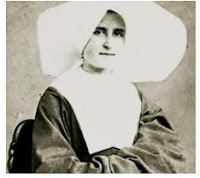May 4-5 2019: 3rd Sunday of Easter
One of the holiest shrines in all of Christendom was hidden and unknown for centuries, until it was found in 1891 by a determined French nun. Servant of God Sister Marie de Mandat-Grancey (1837-1915) had a great devotion to the Blessed Virgin Mary. This devotion eventually led her to search for the home of Mary in Ephesus, in modern-day Turkey. Tradition tells us that after the dying Jesus entrusted Mary to the Apostle John, the two settled in Ephesus some time after the Resurrection. They lived in Ephesus for several years, until God assumed Mary into heaven.
The home where they lived was lost to history until Sister Marie worked to find and preserve it.
Marie was raised in a noble family and entered the community of the Daughters of Charity in 1857. Her first assignment was at a French orphanage, where she and six other sisters cared for 55 orphans.
She became head of the Association of the Children of Mary and loved teaching children to be closely united to the Immaculate Heart of Mary. “Be like Mary,” Sister Marie would tell them.
In 1886, she was assigned to a French hospital in Smyrna (now Izmir), Turkey. The hospital was in a deplorable condition, and Sister Marie again used her own family funds to make improvements for the patients and staff, while she lived in poverty.
It was during her time there that she read German mystic Blessed Anne Catherine Emmerich’s writings on the life of the Blessed Virgin Mary and St. John at Ephesus.
Emmerich’s writings are based on visions she had of Mary’s life, including visions of Mary’s house.
Convinced that this sacred site must be located and honored, Sr. Marie began a mission to find it. She urged two priest friends to read Blessed Anne’s writings, and the three of them determined that the house would have existed just a short distance from where they were all providentially assigned.
The first search expedition to find Mary’s house took place in July 1891. The group, made up of the priests, Sr Marie, and guides, went by donkey and used Blessed Anne’s book of private revelations as their map. On July 29, they believed they had found the house.
Under Sister Marie’s guidance, archaeologists identified the ruins of a 1st-century home, with a church from the 4th century having been built over it.
On Oct. 21, 1891, Sister Marie received permission to purchase the property in her name. She asked her father for the money needed to buy not only the area of the house, but the whole mountain on which the house stands.
The property was purchased on November 15, 1892. She then worked tirelessly to restore the house, making it a place of pilgrimage. Sister Marie remained in this area, caring for Muslims and Christians, until her death.
During restoration, three stones from the hearth, believed to have been built by the apostle, were found. The corner-stone was given to the de Mandat-Grancey family chapel in France in acknowledgement of Sister Marie’s holy life.
Sister Marie lived a life of detachment, virtue, obedience and charity. Her cause of beatification was opened on January 21, 2011.
Pope Leo XIII encouraged visits to the site, declaring it a place of pilgrimage. On Aug. 18, 1961, Pope St. John XXIII granted plenary indulgences upon Mary’s house for all time. Popes Paul VI, John Paul II and Benedict XVI each made trips there, and more than one million people visit every year. For Christians and many others around the world, it is a sacred site to visit.
You can do a virtual tour of the house and learn more about Sr. Mary and the sacred area www.SisterMarie.com
“From here in Ephesus, a city blessed by the presence of Mary Most Holy — who we know is loved and venerated also by Muslims — let us lift up to the Lord a special prayer for peace between peoples.” – Pope Benedict XVI, Papal Homily at “Mary’s House” in Ephesus, Turkey, November 29, 2006.
Patty Knap, Aleteia | Apr 24, 2017

